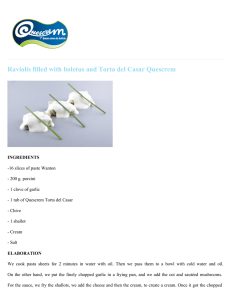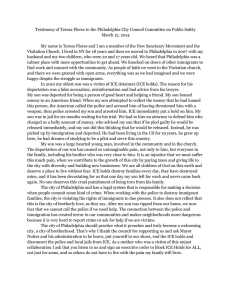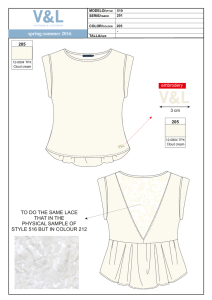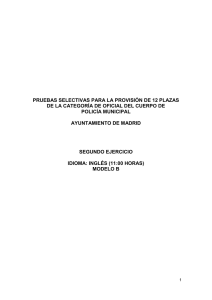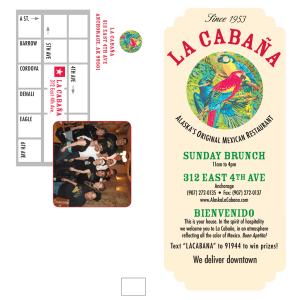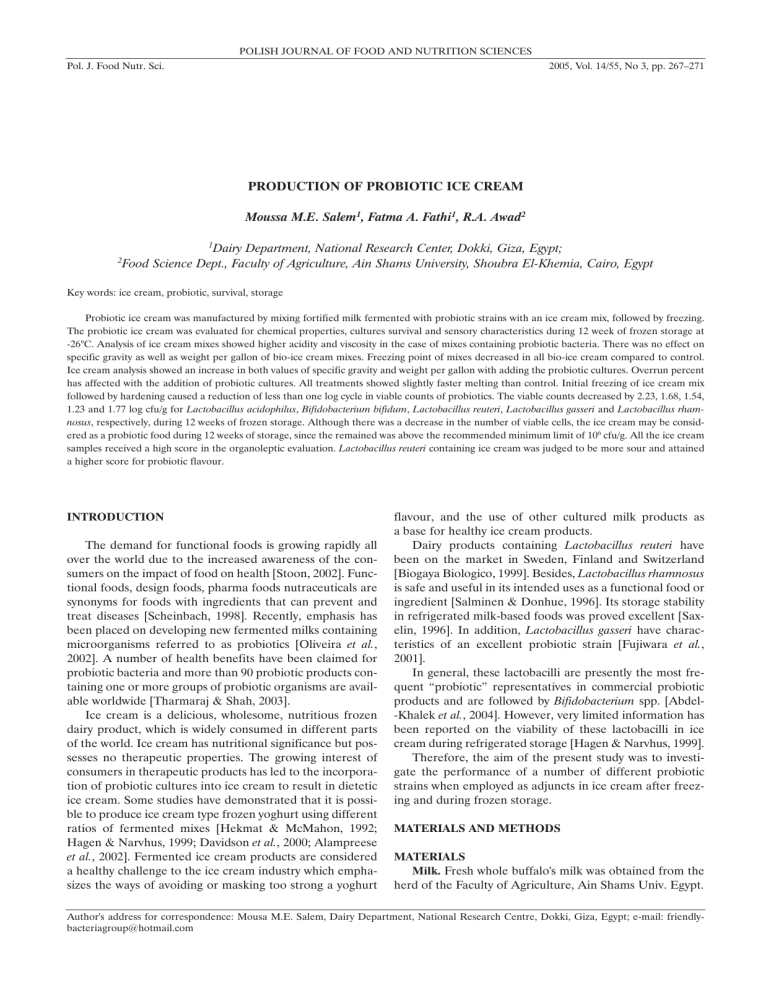
POLISH JOURNAL OF FOOD AND NUTRITION SCIENCES Pol. J. Food Nutr. Sci. 2005, Vol. 14/55, No 3, pp. 267–271 PRODUCTION OF PROBIOTIC ICE CREAM Moussa M.E. Salem1, Fatma A. Fathi1, R.A. Awad2 1 Dairy Department, National Research Center, Dokki, Giza, Egypt; Food Science Dept., Faculty of Agriculture, Ain Shams University, Shoubra El-Khemia, Cairo, Egypt 2 Key words: ice cream, probiotic, survival, storage Probiotic ice cream was manufactured by mixing fortified milk fermented with probiotic strains with an ice cream mix, followed by freezing. The probiotic ice cream was evaluated for chemical properties, cultures survival and sensory characteristics during 12 week of frozen storage at -26°C. Analysis of ice cream mixes showed higher acidity and viscosity in the case of mixes containing probiotic bacteria. There was no effect on specific gravity as well as weight per gallon of bio-ice cream mixes. Freezing point of mixes decreased in all bio-ice cream compared to control. Ice cream analysis showed an increase in both values of specific gravity and weight per gallon with adding the probiotic cultures. Overrun percent has affected with the addition of probiotic cultures. All treatments showed slightly faster melting than control. Initial freezing of ice cream mix followed by hardening caused a reduction of less than one log cycle in viable counts of probiotics. The viable counts decreased by 2.23, 1.68, 1.54, 1.23 and 1.77 log cfu/g for Lactobacillus acidophilus, Bifidobacterium bifidum, Lactobacillus reuteri, Lactobacillus gasseri and Lactobacillus rhamnosus, respectively, during 12 weeks of frozen storage. Although there was a decrease in the number of viable cells, the ice cream may be considered as a probiotic food during 12 weeks of storage, since the remained was above the recommended minimum limit of 106 cfu/g. All the ice cream samples received a high score in the organoleptic evaluation. Lactobacillus reuteri containing ice cream was judged to be more sour and attained a higher score for probiotic flavour. INTRODUCTION The demand for functional foods is growing rapidly all over the world due to the increased awareness of the consumers on the impact of food on health [Stoon, 2002]. Functional foods, design foods, pharma foods nutraceuticals are synonyms for foods with ingredients that can prevent and treat diseases [Scheinbach, 1998]. Recently, emphasis has been placed on developing new fermented milks containing microorganisms referred to as probiotics [Oliveira et al., 2002]. A number of health benefits have been claimed for probiotic bacteria and more than 90 probiotic products containing one or more groups of probiotic organisms are available worldwide [Tharmaraj & Shah, 2003]. Ice cream is a delicious, wholesome, nutritious frozen dairy product, which is widely consumed in different parts of the world. Ice cream has nutritional significance but possesses no therapeutic properties. The growing interest of consumers in therapeutic products has led to the incorporation of probiotic cultures into ice cream to result in dietetic ice cream. Some studies have demonstrated that it is possible to produce ice cream type frozen yoghurt using different ratios of fermented mixes [Hekmat & McMahon, 1992; Hagen & Narvhus, 1999; Davidson et al., 2000; Alampreese et al., 2002]. Fermented ice cream products are considered a healthy challenge to the ice cream industry which emphasizes the ways of avoiding or masking too strong a yoghurt flavour, and the use of other cultured milk products as a base for healthy ice cream products. Dairy products containing Lactobacillus reuteri have been on the market in Sweden, Finland and Switzerland [Biogaya Biologico, 1999]. Besides, Lactobacillus rhamnosus is safe and useful in its intended uses as a functional food or ingredient [Salminen & Donhue, 1996]. Its storage stability in refrigerated milk-based foods was proved excellent [Saxelin, 1996]. In addition, Lactobacillus gasseri have characteristics of an excellent probiotic strain [Fujiwara et al., 2001]. In general, these lactobacilli are presently the most frequent “probiotic” representatives in commercial probiotic products and are followed by Bifidobacterium spp. [Abdel-Khalek et al., 2004]. However, very limited information has been reported on the viability of these lactobacilli in ice cream during refrigerated storage [Hagen & Narvhus, 1999]. Therefore, the aim of the present study was to investigate the performance of a number of different probiotic strains when employed as adjuncts in ice cream after freezing and during frozen storage. MATERIALS AND METHODS MATERIALS Milk. Fresh whole buffalo's milk was obtained from the herd of the Faculty of Agriculture, Ain Shams Univ. Egypt. Author's address for correspondence: Mousa M.E. Salem, Dairy Department, National Research Centre, Dokki, Giza, Egypt; e-mail: friendlybacteriagroup@hotmail.com 268 Probiotic strains. Five different cultures were used. Lactobacillus gasseri B-14168, Lactobacillus rhamnosus B-445 and Lactobacillus reuteri B-14171 were provided by Northern Regional Research Laboratory, Illinois, USA (NRRL). Lactobacillus acidophilus La-5 (DVS) and Bifidobacterium bifidum Bb-12 (DVS) were obtained from ChrHansen's Lab., Denmark. All strains had previously been shown to demonstrate probiotic properties [Amin et al., 2002]. Additives. Use was made of the following additives: (1) skim milk powder, Hoogwegt, Poland; (2) vanilla and sugar, local market; and (3) stabilizer-emulsifier, Cremondan SE 38 veg. Danisco Ingredients, Denmark. METHODS Procedure for ice cream manufacturing. Six ice cream mixes (2 kg each), each of three replicates, were prepared. All mixes were standardized to contain, 8% fat, 12% milk solids not fat, 16% sugar, 0.8% stabilizer/emulsifier, and 0.3% vanilla. In each treatment, mix ingredients were homogenized together as described by Arbuckle [1986] and then heated at 80°C for 30 sec as suggested by Rothwell [1976]. All mixes were cooled to 5°C and aged overnight at the same temperature. Each strain was cultured for 12 h at 37°C in sterilized-skimmed milk, fortified by the addition of 1% D-glucose (Puriss, Kebbo Lab. AB, 50% w/v filter sterilized solution) and 1% tryptone (Oxoid, 25% w/v filter sterilized solution) as described by Hagen and Narvhus [1999]. This fermented milk was then added (10% v/v) to five ice cream mixes prior to freezing. Treatment 1 was applied as a control, without addition of fermented milk. Treatments (T2, T3, T4, T5 and T6) were made using fermented milk with L. gasseri, L. rhamnosus, L. reuteri, L. acidophilus and B. bifidum, respectively. The freezing was performed in a horizontal batch freezer (Taylor Co., USA). The ice cream was filled in 120 mL plastic cups, covered and hardened at -26°C for 24 h before analysis. Chemical analyses. Titratable acidity and pH values of mixes were determined according to Richardson [1986]. Acidity of mixes was determined in duplicate by titration with NaOH 0.1N, using phenolphthalein as an indicator. Specific gravity, weight per gallon, overrun, freezing point, and melting resistance of ice cream were determined according to Arbuckle [1986]. Ice cream overrun was determined on samples stored at -26°C for 5 days by the following equation: Overrun % = 100 × (ice cream volume – mix volume) × (mix volume)-1 Mix volumes were calculated dividing ice cream sample weight by mix density measured at 5°C. Results are the average of five replicates. The viscosity was determined according to Awad and Metwally [2000] using a coaxial rotational viscometer (Rheotest II, Germany). Apparent viscosity was calculated at shear time of 48.6 sec-1. Bacteriological analyses. Bacterial counts were estimated after 12-h fermentation, immediately after mixing, after freezing, and after 1, 4, 8 and 12 weeks of frozen storage at -26°C. M.M.E. Salem et al. The viable number of L. gasseri was estimated by plating on MRS agar (Oxoid) according to IDF [1995] and incubating anaerobically for 3 days (37°C). Viability of L. reuteri and L. rhamnosus was determined on MRS-arabinose agar following 2-day incubation at 37°C [Effat, 2000] and on LC agar following 3–4 days of incubation at 27°C [Ravula & Shah, 1998] under anaerobic conditions, respectively. Lactobacillus acidophilus was determined on Lactobacillus selective agar plus 0.2% oxgall (LBSO) [Gilliland & Walker, 1990]. Plates were incubated at 37°C for 4 days. Enumeration of B. bifidum was done according to Blanchette et al. [1996] using modified MRS agar (Oxoid) supplemented with 0.05% L. cysteine-HCl (Merck, Germany). Plates were incubated at 37°C for 48 h. In both cases, plates were incubated in an anaerobic environment (BBL Gas Pak, Becton Dickinson, Cockeysville MA, USA). Sensory evaluation. The bio-ice cream was organoleptically evaluated after 2 weeks of storage according to Arbuckle [1986] for flavour (45 points), body and texture (35 points), colour (10 points) and melting quality (10 points) by 20 panelists of the experienced staff members of the Dairy Science Department, National Research Center. RESULTS AND DISCUSSION Physicochemical properties of bio-ice cream mixes As one can see in Table 1, using this technology, ice cream with pH of around 6.26-6.42 and titratable acidity ranging from 0.24%-0.27% was obtained. Although the pH of the added fermented milk was between 4.36 (L. reuteri) and 5.66 (L. acidophilus), the pH of the total mix was high, due to the high buffering capacity of the ice cream mix [Hagen & Narvhus, 1999]. To a certain degree, this would suppress the probiotic flavour. Hekmat and McMahon [1992] found the preferred pH of probiotic ice cream, based on overall acceptance to be 5.5. The pH can be reduced by adding different amounts of fermented milk to the ice cream mix. Christiansen et al. [1996] made batches of experimental ice cream mix by adding from 25 to 50% of commercial cultured milks, fermented with L. acidophilus and B. bifidum. There was no effect of added fermented milks with different cultures on specific gravity as well as weight per gallon of bio-ice cream mixes (Table 1). The data indicated that the freezing point of mixes decreased in all bio-ice cream compared to that of the regular one (control). The high acid material added to the mix would change the state of solubility and molecular weight of some mix components such as milk salts and lactose. The freezing point is usually affected by the amount, type and molecular weight of solutes in the mix [Arbuckle, 1986]. Apparent viscosity values of probiotic ice cream mixes at a shear rate of 48.6 sec-1 revealed that the addition of fermented milk with different cultures led to a slight increase in mix viscosity (Table 1). It could be noticed that among all bio-ice cream mixes, L. reuteri showed the highest viscosity, whereas the one with L. acidophilus demonstrated the lowest values of that characteristic. The higher viscosity values 269 Production of functional ice cream TABLE 1. Physicochemical properties of bio-ice cream mixes made with different probiotic cultures. Treatments Titratable acidity (%) pH values Specific gravity Weight per gallon Freezing point Apparent viscosity (cp) at 48.6 sec-1 T1 (control) 0.22 6.60 1.2256 10.221 -2.14 105.81 T2 (L. gasseri) 0.26 6.31 1.2323 10.277 -2.57 118.94 T3 (L. rhamnosus) 0.26 6.30 1.2321 10.275 -2.51 116.36 T4 (L. reuteri) 0.27 6.26 1.2278 10.239 -2.76 122.55 T5 (L. acidophilus) 0.24 6.42 1.2386 10.329 -2.35 111.42 T6 (B. bifidum) 0.25 6.35 1.2261 10.225 -2.45 114.01 Resultant bio-ice cream properties The properties of bio-ice cream from different treatments were illustrated in Table 2. Specific gravity as well as weight per gallon of bio-ice cream were affected by the addition of probiotic cultures. Both values of specific gravity and weight per gallon increased with adding the probiotic cultures to the ice cream mix compared to the control. Among bio-ice cream treatments, their values were the highest in T4 with L. reuteri and the lowest in T5 with L. acidophilus. The specific gravity of resultant ice cream depends on the form of ingredients used and the ability of mix to retain air bubbles and therefore the overrun percent in the resultant ice cream. Consequently, the overrun percent has affected with the addition of probiotic cultures. While the best and highest overrun was obtained in the mix containing L. acidophilus and B. bifidum, the lowest overrun was with T4 containing L. reuteri. The overrun percent in resultant ice cream is affected by different factors such as the state and nature of proteins, acidity, freezing point, etc., in the mix. Differences in overrun of bio-ice cream are attributed to the different acidity degree in the mix with different probiotic cultures which affected the freezing point and/or the nature of proteins. Bio-ice cream samples showed different melting behaviour as a function of added probiotic cultures to ice cream mix (Table 2). All treatments showed slightly faster melting than the control without probiotic culture. The treatment with L. rhamnosus (T3) was the fastest in melting, whereas the treatment with L. acidophilus La-5 (T5) was the slowest among all treatments with probiotic cultures. T5 and T6 (B. bifidum Bb-12) were closest treatments to control ice cream in respect of melting behaviour. The differences in melting resistance of bio-ice cream treatments may be attributed to the differences in freezing points and viscosity of recipes. Viability of probiotic bacteria in ice cream Figure 1 shows the viability of probiotic bacteria in fermented milk (12 h; milk fermented for 12 h), mix and ice cream. The fermented milk was added to an ordinary ice cream mix at a rate of 10% (v/v) and the number of viable probiotic bacteria in the complete ice cream mix was thereby decreased by 1 log unit (Figure 1). These results matched those reported by Hagen and Narvhus [1999]. 10 8 Log CFU/G of bio-ice cream could be related to slight protein precipitation due to the higher acidity and lower pH values of mixes compared to excess mix viscosity, decreased whipping rate and a less stable mix. 6 4 2 0 Milk fermented for 12 h Ice cream mix L. acidophilus Ice cream (0) 1 week 4 weeks 8 weeks 12 weeks Ice cream B. bifidum L. reuteri L. gasseri L. rhamnosus FIGURE 1. Survival of various probiotic bacteria in ice cream during 12 weeks of frozen storage. Initial freezing of the ice cream mix in the batch freezer followed by hardening at -26°C caused a reduction of less than one log cycle in total colony count of probiotics. The numbers in the frozen ice cream were found to be in the range of 7.48 log cfu/g for L. acidophilus, 7.90 log cfu/g for B. bifidum, 8.16 cfu/g for L. reuteri, 7 log cfu/g for L. gasseri, and 7.80 log cfu/g for L. rhamnosus (Figure 1). These results concur with those of Hekmat and McMahon [1992] and Hagen and Narvhus [1999] who also found that the numbers of probiotic bacteria decreased by 0.7–0.8 log unit in ice cream during freezing or shortly afterwards. During 12 weeks of frozen storage, L. acidophilus, B. bifidum, L. reuteri, L. gasseri and L. rhamnosus decreased by 2.23, 1.68, 1.54, 1.23 and 1.77 log cfu/g, respectively. It is TABLE 2. Properties of resultant bio-ice cream made with different probiotic cultures. Treatments Specific gravity Weight per gallon Overrun (%) 15 min 30 min Total melting after 45 min 60 min 75 min 90 min T1 (control) 0.7285 6.076 68.24 0.55 5.20 20.86 47.27 76.14 98.6 T2 (L. gasseri) 0.7671 6.398 60.64 4.7 9.55 31.63 65.62 90.59 98.9 T3 (L. rhamnosus) 0.7578 6.320 61.80 5.05 10.75 34.95 72.65 94.56 99.0 T4 (L. reuteri) 0.7687 6.411 59.72 4.55 9.09 31.22 63.48 90.36 99.1 T5 (L. acidophilus) 0.7444 6.208 65.52 3.50 8.69 27.87 57.00 81.90 99.0 T6 (B. bifidum) 0.7549 6.296 64.07 3.0 8.90 29.32 61.03 88.47 98.5 270 M.M.E. Salem et al. clear that the decline in bacterial numbers, due to the freezing step, is most likely to be due to the actual freezing of all the cells, resulting in the death of some cells. However, the mechanical stresses of the mixing and freezing process and also the incorporation of oxygen into the mix, might have resulted in a further decrease in the bacterial count [Hagen & Narvhus, 1999]. Our results show that ice cream still has higher numbers of viable organisms throughout 12 weeks of storage at -26°C and all were above the recommended minimum limit of 106 cfu/g. Hekmat and McMahon [1992] and Mohamed et al. [1998] found that both L. acidophilus and B. bifidum were able to survive in frozen yoghurt. Holcomb et al. [1991] studied the viability of L. acidophilus and B. bifidum in soft serve frozen yoghurt. Their study indicated that both bacteria were able to survive and grow in frozen yoghurt before and after freezing. In addition, Fathi [1999] found that B. bifidum can remain viable during frozen storage of different ice cream types. Also, Hagen and Narvhus [1999] observed that the viable count of L. acidophilus, B. bifidum, L. reuteri and L. rhamnosus did not change significantly during 52 weeks of frozen storage in ice cream and remained above the recommended minimum limit of 106 cfu/g. Recently, others have also demonstrated that probiotic bacteria (e.g., L. johnsonii La1 and L. acidophilus) are capable of surviving in ice cream [Alamprese et al., 2002; Andrighetto & Gomes, 2003]. More recently, Hamed et al. [2004] observed no evidence of freeze injury to B. bifidum in frozen yoghurt over 10 weeks of frozen storage. be more sour and attained a higher score for probiotic flavour than other bio-ice cream samples. All bio-ice cream treatments scored slightly lower values in melting quality and colour attributes than the control treatment. This could be due to the higher acidity and heat process for the milk fermented with cultures, which may affect the melting behaviour and colour of resultant ice cream. None of the ice cream samples were judged to be icy in texture. All ice cream samples supplemented with the probiotic strains were acceptable and gave a good total impression with no marked off-flavour. Among all treatments, the high palatable samples were those supplemented with B. bifidum Bb-12 and L. reuteri B-14171. These findings were in line with those of Hagen and Narvhus [1999]. Sensory evaluation Table 3 shows the averages of sensory attributes of bio-ice cream containing various probiotic bacteria. According to the panelists, ice cream prepared with L. reuteri (T4) and B. bifidum (T6) was given the highest scores for flavour, body and texture, colour as well as melting quality among all treatments. On the other hand, bio-ice cream with L. rhamnosus (T3) was the lowest preferred sample and obtained the lowest score especially in flavour attribute. The probiotic taste was not found to be particularly noticeable in all bio-ice cream samples. One reason for this could be the high pH value of resultant ice-cream. Bio-ice cream samples of L. reuteri (T4) and B. bifidum (T6) were described to have a clean and pleasant taste with no detectable off flavour. While, ice cream samples with L. acidophilus (T5) has lowest acidity and good body and texture as that of L. reuteri (T4), it was less preferred in flavour. L. reuteri containing ice cream (T4) was judged to 1. Abdel-Khalek A.B., Effat B.A., Sharaf O.M., The use of L. gasseri, L. johnsonii and genetically modified L. delbreuckii ssp. bulgaricus in functional yoghurt-like product. Egypt. J. Dairy Sci., 2004, 32, 245–259. 2. Alamprese C., Foschino R., Rossi M., Pompei C., Savani L., Survival of Lactobacillus johnsonii La1 and influence of its addition in retail-manufactured ice cream produced with different sugar and fat concentrations. Int. Dairy J., 2002, 12, 201–208. 3. Amin G.A., El-Gizawy S.A., Tawfik N.F., Abdel-Khalek A.B., Utilization of some microorganisms as the dietary adjuncts under local conditions. II. Selection of isolates for the probiotic characteristics. 2nd Cong. Res. of Recent Technologies in Agriculture, 2002, 1, 104–113. 4. Andighetto C., Gomes M.I.F.V., Production of ice cream using acidophilus milk. Braz. J. Food Tech., 2003, 6, 267–271. 5. Arbuckle W.S., Ice Cream. Second Ed., 1986., AVI Publishing Company Inc., Westport, Connecticut, USA pp. 325–326. 6. Awad R.A., Metwally A.I., Evaluation of total milk proteinate as a milk solids source in ice cream manufacture. Annals Agric. Sci., Ain Shams Univ., Cairo, 2000, 45, 603–618. 7. Biogaya Biologics, Applied biological systems for improving health and enhancing protection from disease, Lactobacillus reuteri. Company's documentation, Biogaya, 1999, Stockholm, pp. 1–19. 8. Blanchette L., Roy D., Belanger G., Gauthier S.F., Production of cottage cheese using dressing fermented by bifidobacteria. J. Dairy Sci., 1996, 79, 8–15. TABLE 3. Sensory evaluation scores of bio-ice cream made with different probiotic cultures. Treatments Flavour (45) Body and texture (35) Colour Melting quality Total score (10) (10) (100) T1 (control) 42 34 9 9 94 T2 (L. gasseri) 40 30 7 8 85 T3 (L. rhamnosus) 38 30 7 7 82 T4 (L. reuteri) 41 32 8 8 89 T5 (L. acidophilus) 39 32 8 7 86 T6 (B. bifidum) 41 33 8 8 90 CONCLUSIONS Ice cream is good enough and the concentration of living bacteria fulfills demand for probiotic products. Ice cream can serve as an excellent vehicle for dietary incorporation of probiotic bacteria. Frozen storage of the products has little effect on cultures survival, and bacterial cultures remained at levels sufficient to offer the suggested therapeutic effects. Supplementation with probiotic bacteria has been found to exert a little effect on flavour or compositional characteristics of ice cream. REFERENCES Production of functional ice cream 9. Christiansen J.R., Edelsten C.D., Nielsen E.W., Some properties of ice cream containing Bifidobacterium bifidum and Lactobacillus acidophilus. Milchwissenschaft, 1996, 51, 502–504. 10. Davidson R.H., Duncan S.E., Hackney C.R., Eigel W.N., Boling J.W., Probiotic culture survival and implications in fermented frozen yogurt characteristics. J. Dairy Sci., 2000, 83, 666–673. 11. Effat B.A., Effect of using Lactobacillus reuteri with other probiotic cultures on quality of Domiati cheese. Minufiya J. Agric. Res., 2000, 25, 445–460. 12. Fathi F.A., Survival of Bifidobacterium bifidum in ice cream supplemented with fruit syrup for use as a probiotic food. J. Agric. Sci. Mansoura Univ., 1999, 24, 743–748. 13. Fujiwara S., Seto Y., Kimura A., Hashiba H., Establishment of orally-administered Lactobacillus gasseri SBT 2055 in the gastrointestinal tract of humans and its influence on intestinal microflora and metabolism. J. Microbiol., 2001, 90, 343–348. 14. Gilliland S.E., Walker K., Factors to consider when selecting a culture of L. acidophilus as a dietary adjunct to produce a hypocholesteralmic effect in humans. J. Dairy Sci., 1990, 73, 905–911. 15. Hagen M., Narvhus J.A., Production of ice cream containing probiotic bacteria. Milchwissenschaft, 1999, 54, 265–268. 16. Hamed A.I., Zedan M.A., Salem O.M., Moussa A.M., Yousef E.T.A., Impact of frozen yoghurt ingredients on its quality and survival of bifidobacteria. ii. Effect of milk solids not fat sources. Proc. the 9th Egyptian Conf. for Dairy Sci. & Tech. “Milk and Dairy Products for a Health Future”, 9–11 Octpber, 2004, pp. 227–242. 17. Hekmat S., McMahon D.J., Survival of Lactobacillus acidophilus and Bifidobacterium bifidum in ice cream for use as a probiotic food. J. Dairy Sci., 1992, 75, 1415–1422. 18. Holcomb J.E., Frank J.F., McGregor J.U., Viability of Lactobacillus acidophilus and Bifidobacterium bifidum in soft-serve frozen yogurt. Cult. Dairy Prod. J., 1994, 26, 4–5. 271 19. IDF, International Dairy Federation, Detection and enumeration of Lactobacillus acidophilus culture media. IDF Bulletin, 1995, 306, 23–33. 20. Mohamed O.A., Neamat Alla A.A., Dabiza Nadia M.A., Utilization of Bifidobacterium bifidum and Lactobacillus acidophilus for the manufacture of probiotic ice cream. J. Agric. Sci. Mansoura Univ., 1998, 23, 3919–3934. 21. Oliveira M.N., Sodini I., Remeuf F., Tissier J.P., Corrieu G., Manufacture of fermented lactic beverages containing probiotic cultures. J. Food Sci., 2002, 67, 2336–2340. 22. Ravula R.R., Shah N.,. Selective enumeration of Lactobacillus casei from yoghurts and fermented milk drinks. Biotechnology Techniques, 1998, 12, 819–822. 23. Richardson H.G., Standard Methods for the Examination of Dairy Products, 15th Ed., 1986, American Public Health Association, Washington D.C. 24. Rothwell J., Ice cream, its present day manufacture and some problems. J. Soc. Dairy Technol., 1976, 29, 161–165. 25. Salminen S.J., Donohue D.C., Safety assessment of Lactobacillus strain GG (ATCC53103). Nutr. Today Suppl., 1996, 31, 12S–15S. 26. Saxelin M., Colonization of the human gastrointestinal tract by probiotic bacteria. Nutr. Today Suppl., 1996, 31, 55–85. 27. Scheinbach S., Probiotics: functionality and commercial status. Biotechnol. Adv., 1998, 16, 581–608. 28. Stoon A.E., The top 10 functional food trends. The next generation. Food Technol., 2002, 56, 32–37. 29. Tharmaraj N., Shah N.P., Selective enumeration of Lactobacillus delbreuckii ssp. bulgaricus, Streptococcus thermophilus, Lactobacillus acidophilus, Bifidobacteria, Lactobacillus casei, Lactobacillus rhamnosus and propionibacteria. J. Dairy Sci., 2003, 86, 2288–2296. Received February 2005. Revision received March and accepted June 2005.
